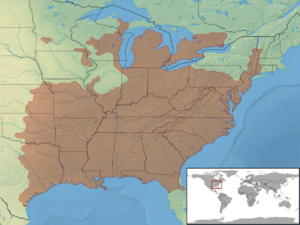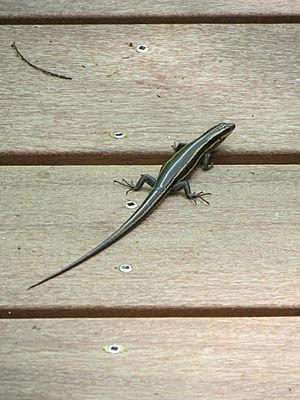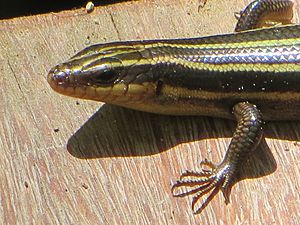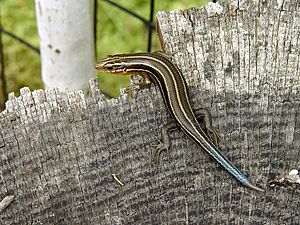Plestiodon fasciatus facts for kids
Quick facts for kids Plestiodon fasciatus |
|
|---|---|
 |
|
| Adult male | |
 |
|
| Juvenile | |
| Scientific classification | |
| Genus: |
Plestiodon
|
| Species: |
fasciatus
|
 |
|
| Synonyms | |
|
|
The American five-lined skink (Plestiodon fasciatus) is a type of lizard. It belongs to the skink family and lives only in North America. This lizard is very common in the eastern U.S. It is also one of the seven types of lizards found in Canada.
Contents
Cool Names for the Skink
This skink has a few different common names!
- Young skinks are often called blue-tailed skinks because their tails are a bright blue color.
- Adult skinks, especially males, can be called red-headed skinks because their heads turn reddish.
- To be super clear, it's best to call it the American five-lined skink. This helps tell it apart from a similar skink in Africa.
- Sometimes, people call it the eastern red-headed skink. This helps tell it apart from a different skink found in the western U.S.
What Does It Look Like?
The American five-lined skink is a small to medium-sized lizard. It can grow to be about 12.5 to 21.5 centimeters (5 to 8.5 inches) long, including its tail.
- Young Skinks: When they are young, these skinks are dark brown or black. They have five clear white or yellowish stripes running along their body. Their tail is a bright, eye-catching blue!
- Adult Skinks: As they get older, the blue color on their tail fades. It turns into a lighter blue or even brownish color. The stripes on their body might also slowly disappear. Their dark brown body color also fades, so older skinks often look plain brownish.
There are other skinks that look very similar. For example, the southeastern five-lined skink looks almost the same. The broad-headed skink is also hard to tell apart. However, adult male broad-headed skinks are much bigger and have very swollen, red heads, which makes them easier to spot.
Where Do They Live?
The American five-lined skink lives across a wide area.
- In the north, you can find them in southern Ontario, Michigan, and eastern New York.
- Their western boundary is in Minnesota, Missouri, and eastern Kansas.
- They also live in Nebraska, Oklahoma, Florida, Mississippi, Louisiana, and Texas.
They are most common in the southeastern U.S. and along the Gulf Coast. They are also being seen more often in parts of Maryland and northern Virginia.
Where Do They Like to Live?
The American five-lined skink mostly lives on the ground. They like places that are moist and have some trees or woods. These areas give them lots of places to hide. They also need sunny spots where they can warm up. You might also find them inside building walls or in trees. In cooler areas, they can live in rocky places.
Reproduction and Life Cycle
Skinks mate in May. The female skink lays her eggs between May and July, about a month after mating. She lays about 15 to 18 eggs.
- Nest Building: Females find a safe, hidden spot for their eggs. This could be under a rotting log, a tree stump, a loose piece of bark, a rock, or even an old rodent burrow. They like places where the soil is moist.
- The Eggs: The eggs look like parchment, which means they are thin and can be easily damaged. When first laid, they are white and about 1.3 cm (0.5 inches) long. They absorb water from the soil and get bigger.
- Incubation: The eggs take about 24 to 55 days to hatch. The time depends on the temperature.
- Parental Care: Female skinks are very good mothers! They stay with their eggs during this time. They protect them from small predators. They might even move the eggs around or urinate in the nest to keep them moist. They also transfer heat from their bodies to the eggs after basking in the sun. If an egg rolls out of the nest, the mother will roll it back in with her head. She will also eat any rotten eggs.
- Hatching: The young skinks hatch and leave the nest a day or two later.
- Growing Up: American five-lined skinks can live for up to six years. They become adults and can start having their own babies when they are two to three years old.
Skink Behavior
Male skinks have special ways of showing off during mating season. They protect their space from other males. They can tell if another skink is a male or female by looking at them and by sensing chemicals. When a male wants to mate, he gently bites the female's neck.
Female skinks show a lot of care for their eggs. They stay close to the eggs, sometimes coiled around them. This helps keep the eggs safe and at the right temperature and moisture. If there are many females nesting together, they might take turns guarding the eggs and looking for food.
Skinks also have cool ways to escape predators!
- Tail Dropping: If a snake, bird, or other animal tries to catch a skink, the skink can drop its tail. The tail keeps wiggling, which distracts the predator. This gives the skink time to run away to safety.
- Biting: Skinks can also bite to defend themselves.
What Do They Eat?
The American five-lined skink mostly eats small creatures with many legs, like spiders, crickets, and beetles. They also eat other insects. Sometimes, they have been seen eating baby mice, frogs, and even other small lizards.
If you have a pet skink, you can also give them fruits and vegetables!
- Vegetables: Good vegetables for skinks include Brussels sprouts, carrots, leafy greens, and peas.
- Fruits: Skinks enjoy fruits like blueberries, mangos, raspberries, papayas, cantaloupes, strawberries, and figs.
Conservation Status
In Canada, the American five-lined skink is at the very edge of where it can live. This makes them special to scientists.
- The population in the Great Lakes - St. Lawrence area is listed as "special concern" in Ontario and Canada. This means they need to be watched carefully.
- It is against the law to take any of the three types of skinks found in Canada from their natural homes.
- Another group, the Carolinian population, is listed as "endangered" in Ontario and Canada. This means they are at high risk of disappearing.
Keeping Skinks as Pets
You can keep American five-lined skinks as pets, and they don't need too much special care. However, some U.S. states have rules about taking reptiles from the wild. For example, in Maryland, you can't have more than four without a special permit.
A pair of skinks can live in a terrarium (a glass tank) that is about 25-30 gallons. With good care, they can live for 5 to 10 years!
Photo gallery
See also
 In Spanish: Eslizón americano de cinco líneas para niños
In Spanish: Eslizón americano de cinco líneas para niños












